| GS Paper 2: Polity and Governance |
Today’s Article Overview:
- Introduction: Context of the Article
- Key Details
- What is Delimitation?
- Constitutional Changes Post-2019: Governance Structure, Legislative Powers, Comparison with Delhi Assembly, Role of LG, etc.
Introduction:
- The first phase of polling for the Jammu and Kashmir Legislative Assembly is scheduled to start on September 18, 2024.
- This election is notably significant as it is the first since the abrogation of Article 370 in 2019, which fundamentally reshaped the political and constitutional framework of the region.
- The new Assembly will function within a Union Territory (UT) framework rather than as a state, bringing substantial changes to the governance structure.
Key Details:
- Polling Constituencies:
- Voting in the first phase will take place across 24 constituencies.
- Of these, 16 constituencies are situated in southern Kashmir, while 8 are in the Jammu division.
- Security Arrangements:
- Multi-layered security measures have been put in place to ensure order and safety during the elections.
- This includes a heightened presence of security personnel at polling stations and key locations.
- Election Phases:
- The election will be held in three phases: September 18, September 25, and October 12.
- The second phase will cover 26 constituencies, including districts such as Srinagar, Poonch, and Rajouri.
- The final phase will involve 40 constituencies, including Bandipora, Baramulla, and Jammu.
What is Delimitation?
- Overview: Delimitation refers to the process of defining or redrawing the boundaries and limits of electoral constituencies within a country or region that has a legislative body.
- The Delimitation Commission Act, enacted in 1952, established the framework for this process.
- The Delimitation Commission is appointed by the President of India and operates in coordination with the Election Commission of India (ECI).
- Delimitation Commissions have been established on four occasions—1952, 1963, 1973, and 2002—under the respective Acts of 1952, 1962, 1972, and 2002.
- The initial delimitation exercise was conducted by the President, with assistance from the Election Commission, in 1950-51.
Constitutional Changes Post-2019:
- In August 2019, Jammu and Kashmir’s statehood was revoked and the region was split into two Union Territories: Jammu and Kashmir, with a legislature, and Ladakh, without one.
- This reorganization was facilitated by the Jammu and Kashmir Reorganisation Act, 2019, which amended the First Schedule of the Constitution to reflect the new status and established a new governance framework under Article 239, which governs Union Territories.
Governance Structure of Jammu and Kashmir:
- The governance model for Jammu and Kashmir is unique and resembles that of other Union Territories like Delhi and Puducherry, with notable differences.
- Under Article 239A, Jammu and Kashmir will have a Legislative Assembly, akin to Puducherry.
- However, the powers of this Assembly are distinct from those held by states.
Powers of the Legislative Assembly:
- The Jammu and Kashmir Reorganisation Act, 2019 specifies the Legislative Assembly’s powers:
- Section 32 permits the Assembly to make laws on matters in the State List, excluding crucial areas such as public order and police.
- The Assembly can also legislate on subjects in the Concurrent List, provided these laws do not conflict with central legislation.
- Section 36 introduces a crucial condition for financial legislation:
- Financial Bills must receive the Lieutenant Governor’s (LG) recommendation before being introduced in the Assembly.
- This provision gives the LG significant control over financial policies affecting the region.
Comparison with Delhi’s Governance Model:
- Jammu and Kashmir’s governance structure can be compared to that of Delhi, another Union Territory with a legislature.
- Delhi’s powers are limited, with key areas like land, public order, and police under the LG’s direct control.
- Legal disputes between the Delhi government and the LG have frequently arisen, especially concerning control of services (the bureaucracy).
- Similarly, in Jammu and Kashmir, the LG retains control over public order, police, and anti-corruption matters.
- The 2019 Act grants the LG discretion over matters outside the Legislative Assembly’s jurisdiction, thereby enhancing the LG’s influence.
Role of the Lieutenant Governor:
- The Lieutenant Governor in Jammu and Kashmir wields considerable authority, as defined by Section 53 of the 2019 Act.
- The LG has the authority to act autonomously in matters outside the legislative scope of the Assembly, such as the All India Services and the Anti-Corruption Bureau. The LG’s decisions are not easily subject to judicial review, strengthening the office’s administrative power.
- In the lead-up to the elections, various administrative changes have further expanded the LG’s powers, including the appointment of the Advocate General, law officers, and involvement in decisions regarding prosecution and sanctions.
Conclusion:
- The forthcoming Jammu and Kashmir Assembly elections signal a new era in the region’s governance, marked by a dramatically altered political and constitutional landscape post-2019.
- The region has transitioned to operating as a Union Territory with a restricted legislative assembly, much like Delhi and Puducherry, but with increased oversight through the LG’s expanded authority.
- The impact of these changes on governance and the balance of power between the Centre and the region will become clearer as the region adapts to its new political and administrative context.
Explore our courses: https://apnipathshala.com/courses/
Explore Our test Series: https://tests.apnipathshala.com/









